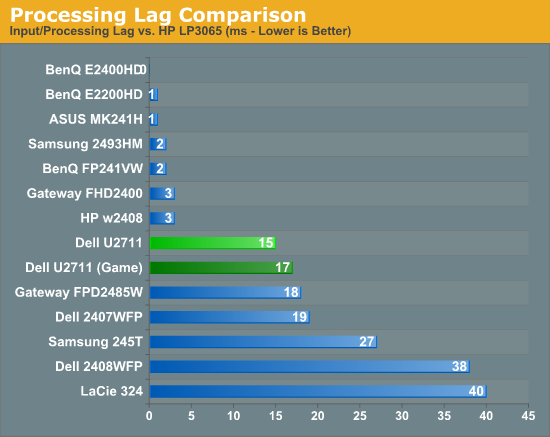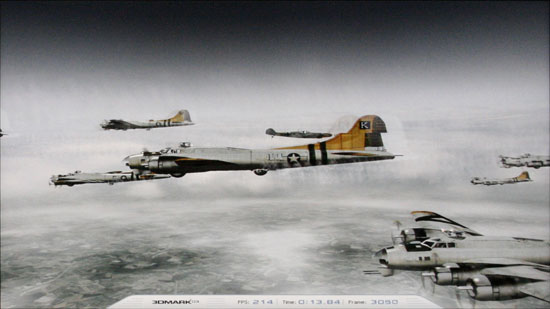Dell UltraSharp U2711: Quality has a Price
by Jarred Walton on January 22, 2010 2:00 AM EST- Posted in
- Displays
Dell U2711 Lag and Response Time
Some users are very concerned with display lag and pixel response time. For others, they really don't notice anything unless a particular display is very sluggish. I fall into the latter camp, though I do notice the processing lag when it's above ~40ms (e.g. on the Dell 2408WFP and LaCie 324, my mouse input just felt off.) To test for display lag, we run the Wings of Fury benchmark in 3DMark03, with the output set to the native LCD resolution - in this case 2560x1440. We clone the output to our reference LCD, an HP LP3065, snap a bunch of pictures, toss out any where the time readout isn't clear, and then average the remaining results (at least 10, and usually 20 or more).
As a reminder, the reference HP LP3065 is one of the best LCDs we currently possess in terms of not having display lag. (The lack of a built-in scaler probably has something to do with this.) While we know some of you would like us to compare performance to a CRT, few users have CRTs these days and all we're really interested in measuring is the relative lag. It's possible we will find an LCD that ends up with a negative result, meaning it's faster than the LP3065, but the best we have managed so far is a tie.

So far, all of the S-PVA panels we have tested show a significant amount of input lag, ranging from 18ms up to 40ms. In contrast, the TN and S-IPS panels show little to no processing lag (relative to the HP LP3065). The BenQ FP241VW with an S-MVA panel performs similarly to the TN and IPS panels, with an average display lag of 2ms - not something you would actually notice compared to other LCDs. What about the new U2711?
We tested with the "Graphics" setting and Adobe RGB as well as "Video" and "Game" - we figured the latter might disable some post-processing and result in less lag. That turned out to be incorrect, as our measured lag actually went up 2ms. However, in practice the settings are pretty much tied. That means the U2711 has around one frame of lag relative to our best LCDs, but it still has a lot less lag than our worst offenders. As stated already, I didn't notice lag in using the U2711 - just like I didn't notice lag on the 2407WFP or the FPD2485W. I did notice slight lag on the Samsung 245T and some clear lag on the 2408WFP and LaCie 324, but the threshold for lag varies and you'll need to determine if 15-17ms is too much or not for you. If you've tried any TN panels and still noticed lag, we would expect every current LCD to be above your "lag threshold".
 |
Despite what the manufacturers might advertise as their average pixel response time, we have found most of the LCDs are basically equal in this area - they all show roughly a one frame "lag", which equates to a response time of around 16ms. Some transitions are faster than others, but the above is representative of what we found in a study of numerous photos. If you look at the tail of the center plane, you can see a slight ghost image before and after the dominant frame. Some of that will come from the camera (we use a 1/120s shutter speed), but most of it comes from the LCD panel. In this case, the U2711 panel does outperform most LCDs that we've tested, where it was often possible to see at least three frames more clearly than the two slight ghosts in the above image.










153 Comments
View All Comments
JarredWalton - Monday, January 25, 2010 - link
I've also tested with the i1 Display2 and achieved essentially the same results (within about 10% on Delta E and within about 2% on gamut). I'm not sure if the Spyder3 is better than both of those, but the i1D2 is pretty well regarded and I've read some stuff in the past where DTP-94 was regarded as one of the better colorimeters. I may play around with the latest version of ColorEyes again just to make sure nothing is wrong. I really don't want to have to invest in another colorimeter, though, since I already have three. :| It would be particularly odd for Spyder3 to be better considering Spyder2 wasn't regarded as being all that great and Spyder3 costs around half as much as the i1D2 or DTP94. But hey, price isn't necessarily a good indicator of quality. Heh.toyotabedzrock - Monday, January 25, 2010 - link
Any chance we will see a review on the U2410? I have heard of problems with it and would like to see your take on it.AngEviL - Sunday, January 24, 2010 - link
Hi Jared, can you please answer me this question ? I had a 22"1680x1050 monitor and I was very annoyed by the "sieve effect". Basically i saw the blackness between the pixels. For that reason mostly i upgraded to a 24" 1920x1200 TN panel lcd and i still spot very well the black between pixels and it is annoying me. Now you will ask how far i am standing from the monitor. I am at 2 thirds of a meter away, or 2 feet, and i really can't go any farther than that because the monitor becomes too small in my field of view.I know that the lower pixel pith will make the blackness between pixels less noticeable, but my question is how much less ? Also, is the proportional distance between pixels smaller compared to other models ? I'm just making this up, but let's say that on a 24" 1920x1200 monitor 90% of the screen space is pixels, and 10% is the black space between them. Does this Dell have less black space proportionally or it maintains the same ration, like 5% black space ?
I ask because i know that the "sieve effect" will be less noticeable on this Dell because of the lower pixel pitch... but how much less compared to a 24" 1920x1200 TN panel ? Thanks.
AngEviL - Sunday, January 24, 2010 - link
In case you think that the monitor i have has larger pixel spacing or something, i do see this sieve effect just as much on my 1440x900 17" laptop (from a normal viewing distance), and on my friend's laptops, as well and it is bothering me as much. Another reason why i ask is because i read somewhere that H-ISP (which i think this panel uses) has less proportional distance between pixels(more space is used up by the actual pixels and less by the blackness between them). I'm wondering if this is really true.JarredWalton - Monday, January 25, 2010 - link
You have better eyes than me, certainly. I can say on the U2711 (and on 30" LCDs), I really can't spot the red green and blue elements that make up white unless I get out a magnifying glass, and I certainly can't see the black between those elements. Well, I suppose I sort of can see the squares that make up the LCD, but that's about it. The U2711 is certainly smaller dots than other desktop LCDs, though.AngEviL - Monday, January 25, 2010 - link
Thanks for the answer.macforth - Monday, January 25, 2010 - link
An interesting article Jarrad. Clearly from the derth of discussion, screens are very important to us all. Although I don't feel that old, and enjoy gaming to the max, I clearly remember the days when there was no such thing as a visual display unit (as we called them when they were first used).Since those heady days in the late 60's we have sure come a long way from those green screens to that which is the subject of your article.
Surprisingly, having read all the post article discussion, no mention has been made of the new 120Hz screens. You did mention 60Hz at one point in the discussion.
I just built a nice gaming PC for a mate, and bought a new 120Hz screen to go with that. All I can say, it beats all the other screens in the house from 30" to 22" to an old 21CRT.......mind you when the CRT was in it's hayday, maybe similar. It is very impressive, and was nowhere near the cost of the sceen in your article.
I do hope that you, or maybe your (hopefully) new writer can have a crack at the new 120Hz movement in screens. Oh!.......the ones available round me (downunder) are 16:10, lol
Keep up the good work!.......
JarredWalton - Monday, January 25, 2010 - link
The big complaint with 120Hz displays is that they're all TN panels (as far as I'm aware). But, TN is often good enough for a lot of people, and it's a lot cheaper than IPS and *VA. I'm hoping to at least get *some* 120Hz LCD for testing in the not-too-distant future.mikeyakame - Sunday, January 24, 2010 - link
I couldn't find the panel type mentioned anywhere, but from what I recall this and the Apple 27" monitors both use the new LG-Phillips 27" H-IPS Panel, not S-IPS.JarredWalton - Sunday, January 24, 2010 - link
I couldn't get any report of the manufacturer; I used to get decent results from Astra32, but now the manufacturers have gotten smart and Dell writes their own name in the firmware. So this panel tells me it's a "Dell U2711". LOL.I don't think I called it an "S-IPS" anywhere; it's just *some* form of IPS, and whether that's H-IPS or S-IPS isn't hugely important. Given contrast is measured at 800:1 to 1000:1 (depending on brightness), H-IPS is entirely possible. But then, refinements to LG's S-IPS might accomplish the same thing.